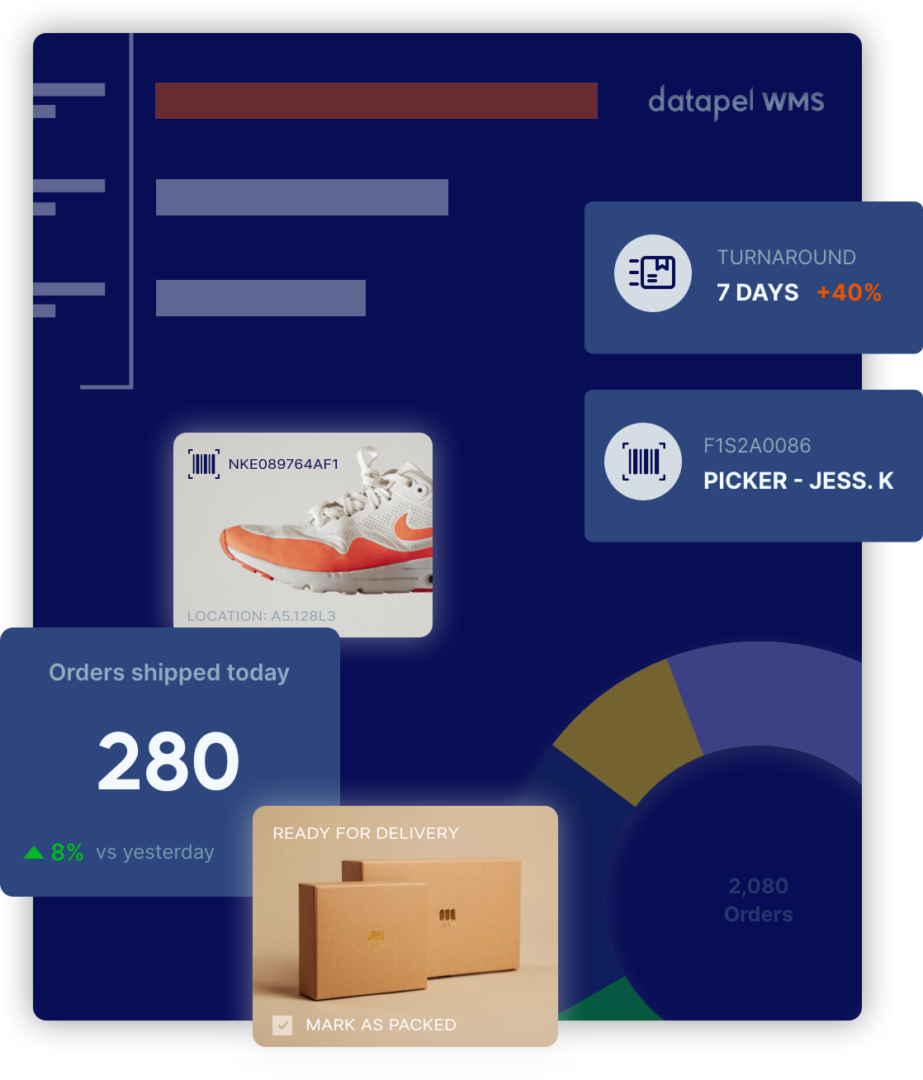Crafting Your eCommerce Fulfilment Plan
Contents
In the world of eCommerce, success isn’t just about having great products or a nice website. It’s about delivering on your promises, literally. As soon as a customer clicks buy now they’re trusting you to get their order to them quickly, safely and efficiently. This is where an eCommerce fulfilment plan comes in.
A good plan can impact customer satisfaction, build brand loyalty and allow your business to scale seamlessly. But how do you create a plan that meets today’s demands and is flexible enough to grow your business?
Let’s get into the essentials of creating an eCommerce fulfilment plan that aligns with your business goals and customer expectations, turning order fulfillment into a competitive advantage.
What is eCommerce Fulfilment?

First off—what is eCommerce fulfilment?
In simple terms, eCommerce fulfilment is all the processes involved in getting a product from your warehouse to the customer’s door. It includes receiving inventory, warehousing, picking and packing orders, shipping and returns.
The fulfilment process is the backbone of your operational efficiency and a customer service touchpoint. In an ecommerce business, expert logistics are crucial to optimise operations and enhance customer satisfaction. Imagine a customer who receives their order late or damaged; one bad experience can outweigh several good ones.
On the other hand, a smooth fulfilment process can turn a one-time buyer into a repeat customer who will come back for more.
Choosing Your Fulfilment Model
One size doesn’t fit all when it comes to fulfilment. There are several models to choose from, each with its pros and cons. The three main models are self-fulfilment, partnering with a third party logistics provider (3PL), and dropshipping.
Self-fulfilment

This is where you manage the whole fulfilment process in-house. While this gives you complete control over your operations, it can be resource-heavy. It’s a good fit for businesses that want direct control over their inventory and can manage inventory effectively to handle the logistics.
Third-party logistics (3PL) Fulfillment Centers

Outsourcing your fulfilment to a 3PL provider can save you time and resources so you can focus on other areas of your business. But you’ll sacrifice some control over the fulfilment process. For many growing businesses the benefits—scale and reduced overheads—outweigh the drawbacks.
Dropshipping Order Fulfilment

In this model, you don’t hold any inventory. When a customer places an order in your online store, you purchase the item from a third party who then ships it to the customer. Dropshipping is a low-risk option that requires minimal upfront investment but comes with lower profit margins and less control over the customer experience.
When choosing a fulfilment model consider your business size, order volume and customer expectations. For example, a small business with a niche product might be suited to self-fulfilment whereas a rapidly scaling business might be better with 3PL. Also, consider how each model aligns with your long-term business goals.
Strategy vs Business Goals

Your fulfilment strategy should mirror your overall business objectives. Whether you’re looking for rapid growth, expanding into new markets or increasing profitability, your strategy needs to support those goals by leveraging ecommerce fulfillment services.
For example, if you’re looking to expand into new markets you’ll need a fulfilment strategy that can handle cross-border logistics. This might mean working with a 3PL provider who has experience in international shipping and customs regulations. On the other hand, if you want to maintain control over the customer experience self-fulfilment might be the way to go even if it’s more resource-heavy.
The balance between cost, control and convenience is key. Outsourcing fulfilment can reduce operational costs but also means less control over the delivery experience. Managing fulfilment in-house means more control but can take resources away from other areas of your business.
Reviewing your fulfilment strategy regularly and aligning it with your changing business goals will ensure it continues to serve you as you grow.
In-House vs Outsourced Fulfilment

The in-house vs outsourced fulfilment debate is one many eCommerce businesses face especially during periods of growth. Each has its pros and cons and the right choice often depends on where your business is in its life cycle and how you manage the fulfillment process.
In-House Fulfilment
Managing fulfilment in-house gives you complete control over the process. This means you can efficiently pick, pack, and ship orders, providing a more personal customer experience and the ability to react quickly to changes in demand.
But the trade-off is the significant investment in warehousing, technology and staff. For smaller businesses or those with very specific fulfilment needs the control of in-house fulfilment can be worth it. But as order volumes grow so do the complexities and costs of managing fulfilment in-house.
Outsourced Fulfilment
Working with a 3PL provider means you can tap into their expertise and infrastructure. This is particularly useful for businesses looking to scale quickly without the overhead of managing their warehousing and logistics.
Outsourced fulfilment gives you the flexibility to adjust your operations to demand fluctuations. But you need to choose a provider that aligns with your brand values and can deliver the level of service your customers expect.
From the industry
It was noted by Ninaad Acharya, co-founder and CEO of Fulfillment IQ, that more companies are outsourcing their fulfilment operations lately, except for businesses with particularly unique or complex fulfilment needs. Success in fulfilment is defined by achieving high throughput and a low cost per unit fulfilled — a challenging task when distribution is not a core competency for many companies.
The decision to move from in-house to outsourced fulfilment or vice versa should be driven by your business’s growth stage and strategic goals.
For example, if you’re growing rapidly and struggling to keep up with order fulfilment, outsourcing might relieve the pressure and free up resources to focus on other growth initiatives. If you want to improve your brand’s customer service reputation, it may be beneficial to handle fulfilment internally, especially if you can offer same day fulfillment.
Conclusion
eCommerce fulfilment is not a one-off task; it’s an ongoing process that encompasses the entire fulfillment process. As your business grows so should your approach to fulfilment. Whether you choose to manage in-house, outsource to a 3PL or go hybrid the key is to review and adjust your strategy regularly to ensure it stays aligned with your business goals and customer expectations.
Remember a well-executed fulfilment strategy is more than just getting product from A to B. It’s about delivering on your brand promise, building customer trust and setting the stage for growth.
And as you refine your strategy think about how technology like Datapel’s Warehouse Management System can support your efforts by streamlining operations, reducing costs and improving inventory control. With the right strategy and tools in place, you’ll be ready to tackle eCommerce fulfilment and turn it into an opportunity for success.
Frequently Asked Questions
1. How to do eCommerce fulfilment?
eCommerce fulfilment involves receiving, storing, picking, packing, and shipping products to customers. You can manage it in-house, outsource to a 3PL provider, or use dropshipping, where the supplier ships directly to customers.
2. What is a fulfilment strategy?
A fulfilment strategy is a plan for managing the storage, packing, and shipping of products. It helps you choose the best fulfilment model (in-house, 3PL, or dropshipping) to meet customer expectations and business goals.
3. What are the different types of eCommerce fulfilment?
The main types are:
- Self-Fulfilment: You handle everything in-house.
- Third-Party Logistics (3PL): You outsource to a fulfilment provider.
- Dropshipping: The supplier ships directly to customers.

In my role, I oversee the development of insightful blogs that delve into the intricacies of warehouse management. Each piece reflects my dedication to empowering businesses through informative content. Through my team’s extensive experience in the industry, we aim to bring clarity to the complexities of WMS, helping businesses make informed decisions.
Join me on a journey through the ever-evolving landscape of warehouse technology as we explore the latest trends, industry insights, and practical tips to streamline your operations. Feel free to connect, and let’s embark on a collaborative exploration of how WMS can redefine your business efficiency.
Cheers to innovation, efficiency, and the exciting world of warehouse management!








